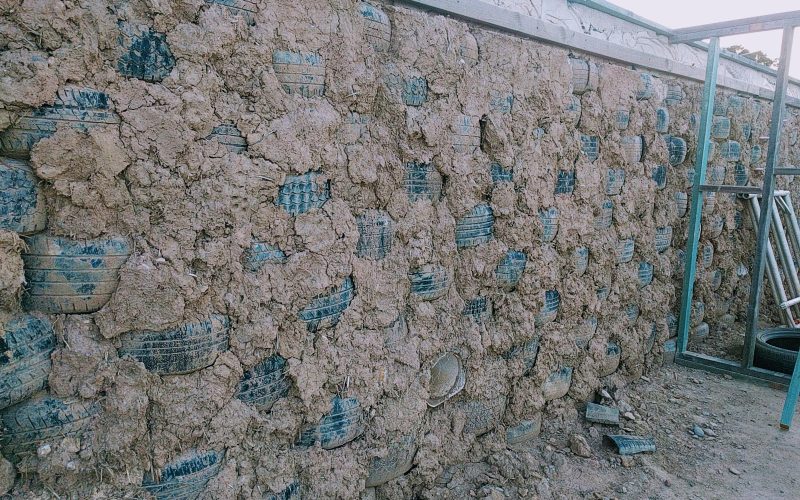Last week my husband and I went on a very special trip. We helped a friend build his Earthship. Okay, we didn’t get anywhere near to an end of the build but it was a great learning experience for us to see first hand what an Earthship is and what it is not.
Let me elaborate.
What is an Earthship?
Very bluntly put, an Earthship is a building made of recycled materials, i.e. rubbish. It is a passive solar building, and it operates in most cases off-grid. The house creates its own power through solar panels and/or wind turbines, uses rainwater, snow, or condensation for its water needs, incorporates wastewater treatment, and includes food production through a greenhouse.
The combination of these principles make a typical Earthship but on their own are not novel.
1. Passive solar house
The idea of a passive solar house drives the design of an Earthship. Passive solar means to make use of solar energy through windows, walls and the floor without using mechanical or electric devices. In an Earthship, this concept means building large sun-facing windows opposite a heavy wall, a wall with thermal mass.
2. Recycled materials
An Earthship typically uses recycled and local materials in its building phase. The thermal mass of the walls is created by tires rammed with earth and through mudbrick walls. In addition to the tire walls, cans, as well as glass bottles, are used as building materials. Depending on the built, other recycled materials such as windows, beams, flooring can be used.
3. Electricity generation
All Earthship designs include a source of electricity generations. There are mostly solar panels and sometimes wind turbines. In any case, power production contributes to the building’s ability to work off-grid.
4. Water collection
All Earthship designs include large rainwater tanks. These tanks are located either underground or fairly visible. The tanks store rainwater for long-term storage and the goal is to provide enough water for the building’s water needs.
5. Sewage treatment
One of the more complex and controversial aspects of an Earthship is its ability to treat sewage. Greywater, i.e. water from the shower, bathroom sink and washing machine, is reused for toilets and as water for the greenhouse. Blackwater, from the toilet and kitchen sink, is dealt with in septic tanks through anaerobic digestion. Blackwater may be used for external gardens after it has been treated.
6. Greenhouse
Every Earthship has a greenhouse in the front of the building. This part of the house receives the most sunlight which means the greenhouse is able to produce a variety of food.
The added bonus of an Earthship – community
In addition to these very functional characteristics of an Earthship comes a global community of sustainable builders. Just like us last week does every Earthship build attract many people. Usually, the beginning of the build which is the tire work is done in a workshop, as well as aspects like mudbrick walls, glass bottle walls, and final rendering. We worked on more structural issues like wall and ceiling frames. But still, we gave up five days of our week to work on something that isn’t ours just to learn.
But it’s not only the physical work which connects people around an Earthship, it’s the idea behind sustainable living. An Earthship is one among a number of examples for building more sustainably and it connects many principles. But, every specific design offers some insight into how to build and live more sustainably and how much more needs to be done.
What an Earthship is not
As enthusiastic as I can get about Earthships, it’s important to keep in mind what the idea (and design) is not.
It is not a final solution to housing on a global scale. Earthships take up a lot of physical space. The site we visited was 25 acres (10 hectares) and was meant for one building. Yes, there is more to go on that property but it will never house (and sustain) more than that one building and all its affiliated operations.
Building an Earthship can only mean to chip away at national building standards. We heard a lot of stories over the days around building codes and council requirements. And the work we did was not Earthship-specific but rather typical for any building in Australia. So, it is important to keep in mind that although the concept is great and should be applied anywhere, local building codes will not be re-written overnight.
Every Earthship is a little revolution!
What I take away
From our five days at an Earthship building site, I take away mixed feelings. I love the design principles that go into the building. Good insulation with lots of light is something every building should strive towards. However, seeing how much space and how many resources go into the house I can see its limitations.
But since I’m an obnoxious optimist I still believe that Earthships are the future. They are the future of making housing more sustainable.



